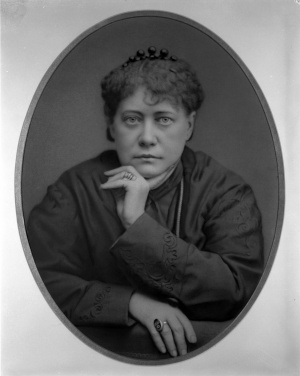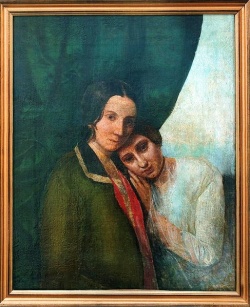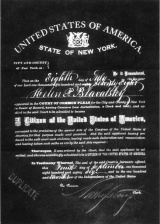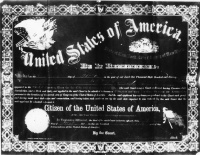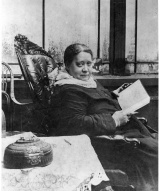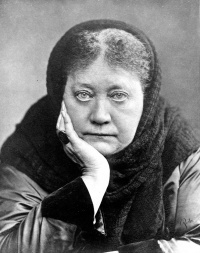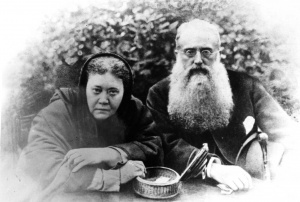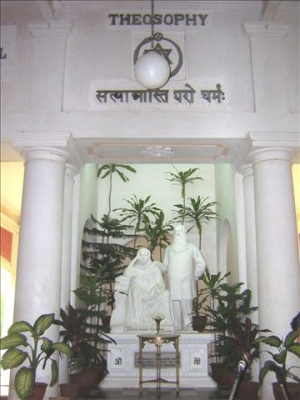Helena Petrovna Blavatsky

THIS ARTICLE IS UNDER CONSTRUCTION
THIS ARTICLE IS UNDER CONSTRUCTION
Helena Petrovna Blavatsky (Russian: Еле́на Петро́вна Блава́тская, Ukrainian: Олена Петрівна Блаватська), was born at Dnepropetrovsk (Ekaterinoslav), Ukraine, on August 12, 1831 (31 July, old style). She was a Theosophist, writer, and traveler.
In 1875 (together with Colonel H. S. Olcott, attorney William Quan Judge and others) she established the Theosophical Society. Blavatsky was the main source of Theosophical teachings and discussed the major themes of Theosophy in many articles and several major works, including Isis Unveiled, The Secret Doctrine, The Key to Theosophy, and The Voice of the Silence. She died in London, on May 8, 1891.
Bllavatsky was instrumental in bringing the spiritual wisdom of the East and that of the ancient Western mysteries to the modern West, where they were virtually unknown.
Early years
Helena Petrovna von Hahn (Russian: Елена Петровна Ган, Ukrainian: Олена Петрівна Ган) was born at Ekaterinoslav in Southern Russia on August 12, 1831 (or July 31 in the Julian Calendar, then current in Russia). She was the first child of Colonel Peter Alexeyevich von Hahn (1798-1873) and Helena Andreyevna Hahn (née de Fadeyev) (1814-1842), a well-known social novelist.
Although no official record has ever been produced of the exact time of her birth, it has been determined with sufficient accuracy by astrological rectification, based on various important events in H.P.B.’s life, to have been 1:42 A.M., local time, which, equated for Greenwich, would be 11:22 P.M., on August 11th, 1831.[1]
Helena was born prematurely. As in 1831 Russia was suffering a widespread epidemic of cholera that had raged several members of her parents’ household, there was fear for the infant’s life. An immediate baptism took place, in which a child who fell asleep holding a candle in the first row behind the officiating priest set fire to his robes during the ceremony.
Helena had a sister Vera Petrovna (April 29, 1835 - 1896) and a brother, Leonid (June, 1840 - November 9, 1885).
According to Vera P. de Zhelihovsky, her mother, at the time, was worried about the destiny of her elder daughter, "gifted from childhood by outstanding features".[2]
The first ten years of Helena’s life were spent in frequent changes from one place of residence to another, partly due to the fact that her father’s battery of Horse-Artillery was being transferred from place to place, and partly because of the precarious health of her mother.[3]
Helena’s mother died on July 6, 1842 at the age of 28 of galloping consumption. Before her death, her mother said: "Well! Perhaps it is for the better that I am dying: at least, I will not suffer from seeing Helena’s hard lot! I am quite sure that her destiny will be not womanly, that she will suffer much".[4] Her father would die was on July 27, 1873, after only three days of illness, while HPB was in New York ready to start her public career.
After her mother’s death, Helena’s grandfather Andrei Mikhailovich and Grandmother Helena Pavlovna (who was an accomplished amateur scientist) took the children to Saratov, where they had quite a different life. Fadeyev’s house was visited by Saratov’s intellectuals.
Helena was clairvoyant from early childhood. In occasions she saw the magestic figure of a Hindu in a white turban who she called her "Protector", since he had saved her in dangers. One of these accidents took place when she was was a young child. Wanting to examine a picture hanging high up on a wall, she piled up a couple of tables and a chair and started climbing. When she reached the painting she lost her balance and remembered nothing else. She then found herself safe on the floor, both tables and the chair standing in their usual places, with the trace of a small hand left on the dusty wall under the picture. Another instance took place when she was 13 years old. She was riding a horse which became frightened and ran away. She fell from her seat, her foot got caught in the stirrup and hung on to it. Instead of being killed she felt someone’s arms around her body supporting her until the horse was stopped.[5]
First marriage
The Winter season of 1848-49 was spent at Tiflis in the mansion of the old Princes Chavchavadze. Striving for full independence 16-year old Helena became betrothed to vice-governor of Erevan, Nikifor Vassilyevich Blavatsky, who was about 40 years old. Their wedding ceremony took place on July 7, 1849. In October Helena left her husband and started on horseback for Tiflis to rejoin her relatives.[6][7] Nikifor Blavatsky tried to obtain a divorce on the ground that "his marriage had never been more than a form." His attempt failed, however, owing to the fact Russian law at the time regarded divorce with disfavor.
It is not certain when Nikifor died. In Helena's scrapbook there is a cutting from a newspaper talking about her life, where we find the sentence: "For many years they [Helena and Nikifor] resided together at Odessa, and finally a legal separation was affected." To this, HPB added two notes. The one commenting on her stay with her husband "for many years" said: "a lie—was with him but for three weeks." To the second phrase: "finally a legal separation was affected" she added "legal, because he died." The name and date of the newspaper do not appear in print, but H.P.B. wrote in ink above the cutting: "From the N. Y. Mercury, Jan. 18, 1875."[8]
Travels
Shortly after her marriage Mme. Blavatsky began more than 20 years of extensive travel all over the world, which is extremely difficult to trace in any coherent manner. Between 1848 and 1875 she went around the world three times in search of wisdom about the nature of life and the reason for human existence. This brought her into contact with mystic traditions the world over. Since she traveled alone, this period of Blavatsky’s life is difficult for her biographers to document, although she wrote and talked about her adventures in later years. N. A. Fadeyeva reported that only her father knew where his daughter was, and from time to time would send money to her. A chronological account of her movements is in Blavatsky’s travels.
Meeting Master Morya
In her Sketchbook, now in the Adyar Archives, Mme. Blavatsky says that she met her Teacher, Master M., in the physical body for the first time at Ramsgate, on her twentieth birthday, August 12, 1851. However, she told Countess Constance Wachtmeister that “Ramsgate” was a blind, and that this took place in Hyde Park, London. She told A. P. Sinnett that this was "in the year of the first Nepal Embassy", that is, in 1850.
It is almost certain that H.P.B. was in London in the Summer of 1854, because she says that she met her Master again "in the house of a stranger in England, where he had come in the company of a dethroned native prince". This was undoubtedly Prince Dhuleep Singh, Mahârâja of Lahore.[9]
In Tibet
The subject of Mme. Blavatsky’s stay in Tibet is wrapped in considerable mystery, as she kept the specific information secret. In 1884 she wrote the following:
I have lived at different periods in Little Tibet as in Great Tibet, and . . . these combined periods form more than seven years. Yet, I have never stated either verbally or over my signature that I had passed seven consecutive years in a convent. What I have said, and repeat now, is, that I have stopped in Lamaistic convents; that I have visited Tzi-gadze, the Tashi-Lhünpo territory and its neighbourhood, and that I have been further in, and in such places of Tibet as have never been visited by any other European, and that he can ever hope to visit.[10]
Sometime during 1852 she attempted to get into Tibet through Nepal. This first attempt failed through what she believed to be the opposition of the British Resident. When she tried to cross the Rangit river, she was see and brought her back.[11]
In 1855 she and some friends formed a plan to penetrate Tibet under various disguises. According to Mr. Sinnett, H.P.B. crossed into Tibetan territory, with the help of a Tartar Shaman who was on his way home to Siberia, while the others were prevented from carrying out their plan.[12]
It is presumed that sometime in 1868 H.P.B. went via India to some parts of Tibet. It is on this journey that she met Master K.H. for the first time, and lived in the house of his sister at Shigadze.[13]
On November 11, 1870, her aunt, Miss Nadyezhda Andreyevna de Fadeyev, received the first known letter from Master K.H. stating that H.P.B. was well and would be back with the family soon.
It is important to bear in mind the term Tibet was then used in a general manner that included not only Tibet proper, but also regions such as Ladakh (then known as Little Tibet).
Société Spirite
In 1871 Mme. Blavatsky embarked for Egypt from Greece, where she had seen Master Hillarion. The ship was carrying guns and gunpowder as a protection against pirates and on July 4, 1871, its powder magazine blew up, with a considerable loss of life. H.P.B., however, was uninjured. She eventually reached Alexandria with hardly any means at all. In October or November she went to Cairo where she met Emma Coulomb (then still Miss Emma Cutting) who was able to loan her some money for the time being.[14]
It was here that H.P.B. made a first attempt at investigating and explaining the nature of phenomena. For that purpose, she formed the Société Spirite (“Spiritist Society”) for the investigation of the Spiritism of the French occultist Allan Kardec. It would appear that this was done against the advice of Paulos Metamon, a well-known Coptic mystic and occultist with whom she was in touch at the time.[15] Her sister Vera de Zhelihovsky, who was in correspondence with her during these years, wrote that H.P.B. chose to start in this way “since there was no other [philosophy available]; to give people a chance to see for themselves how mistaken they were. She would first give room to an already established and accepted teaching and then, when the public would see that nothing was coming out of it, she would then offer her own explanations”.[16]
However, the Société Spirite failed within a fortnight as Blavatsky could not find honest and qualified mediums to do the kind of research she had envisioned.
Life in the United States
Probably in June, 1873, while in Paris, Mme. Blavatsky received an order from her Master to go to New York. She arrived in New York on July 7 and began to work designing illustrated advertising-cards. She also seems to have tried some ornamental leather work, artificial flowers, and cravats.
In July of 1874 Col. Henry S. Olcott became interested in Spiritualism and decided to investigate and report as a journalist the spiritualistic phenomena taking place at the Eddy farmhouse in Chittenden, Vermont. He went back to New York after a few days and published an account for the New York Sun. On September 17 he returned to Chittenden for further investigation and on October 14, acting on instructions received, HPB joined him, quickly becoming friends.
Through her occult training, Mme. Blavatsky had develop psychic abilities that allowed her to command the elementals (certain invisible powers of nature) through which she could perform many phenomena. Col. Olcott began to witness some of these abilities and naturally became very interested in this. As she began to instruct him in the Occult Science and the Esoteric Philosophy, the two started working together in connection with the Spiritualistic movement in the US. During this time, HPB performed at will many phenomena normally ascribed to “the spirits,” and published articles in different spiritualistic journals explaining the origin and nature of these psychic incidents, in ways that contradicted many of the Spiritualists' theories. Most spiritualists were not pleased with HPB’s attempt to reform, sometimes quite radically, their beliefs.
American citizenship
On September 22, 1874, Mme. Blavatsky signs a U.S.A. Government application form expressing her intention to become naturalized.
On July 8, 1878, "Helen P. Blavatsky" appeared in the Court of Common Pleas in New York City and completed the process of applying for citizenship in the United States. She was the first Russian woman to be naturalized as an American citizen.
Second marriage
On April 3, 1875, in New York, a few months before founding the Theosophical Society, Mme. Blavatsky married with a Georgian living in America Michael C. Betanelly. The marriage broke after several months and Betanelly sued for a divorce. The divorce was granted on May 25, 1878, with William Q. Judge acting as Blavatsky's counsel.
The Miracle Club
While living in New York, Mme. Blavatsky started publishing some articles and letters on Spiritualism, Magic, and Occultism. According to Col. Olcott this and "the stories that were afloat about her magical powers, and our several affirmations of the existence of non-human races of spiritual beings, drew into our acquaintanceship numbers of bright, clever people of occult leanings".[17] At this time Mme. Blavatsky recorded the following in her scrap-book:
An attempt in consequence of orders received from T*** B*** through P*** personating John King. Ordered to begin telling the public the truth about the phenomena and their mediums. And now my martyrdom will begin! I shall have all the Spiritualists against me, in addition to the Christians and the Sceptics. Thy will, oh M., be done. H.P.B.[18]
In May 1875 it was decided to form a private investigating committee under the title of the "Miracle Club" where the phenomena of spiritualism would be studied, tested, and demonstrated; "All the manifestations, including materialisations, to occur in the light, and without a cabinet".[19] This attempt, however, failed, mainly because the medium that was to be involved wanted to earn money from this endeavor, something HPB always opposed.
Founding of the Theosophical Society
In July 1875, HPB wrote in her scrapbook: "Orders received from India direct to establish a philosophico-religious society and choose a name for it, also to choose Olcott."[20] On September 7, sixteen or seventeen people joined HPB in her rooms at 46 Irving Place to hear a lecture by George H. Felt on "The Lost Canon of Proportion of the Egyptians, Greeks and Romans." The talk was enthusiastically received and H. S. Olcott wrote on a slip of paper "Would it not be a good thing to form a society from this kind of study?" He handed it to W. Q. Judge to pass it to HPB, who nodded in assent.[21]
At subsequent meetings bylaws were decided upon and officers were elected, with Col. Olcott as President, G. H. Felt and Dr. Seth Pancoast as Vice-Presidents; Madame Blavatsky, Corresponding Secretary; and W. Q. Judge as Counsel to the Society.
On November 17, seventy days after the formation of the Society was proposed, Col. Olcott gave his inaugural address as President-Founder of the newly formed Theosophical Society.
See also Founding of the Theosophical Society.
The "Lamasery"
Since June 1876 till December 1878 Mme. Blavatsky and Col. Olcott lived in an apartment situated at 302 West 47th Street in New York. Known as the "Lamasery", the place became the unofficial headquarters of the newly formed Theosophical Society and a center of attraction for people interested in Occultism, Kabbalah, Spiritualism, Platonism, as well as those curious about phenomena. Col. Olcott and Mr. Judge were nearly always present, and, after the departure of the visitors would remain far into the night immersed in study and discussion.
See also The Lamasery.
Isis Unveiled
H. P. Blavatsky's first major literary effort was Isis Unveiled, a critical response to the growing materialism in both scientific and religious institutions. The book was started in 1875, a few months before the formation of the Theosophical Society, although at the time HPB did not know what was to become of the growing pile of manuscripts.
Described as "A Master-Key to the Mysteries of Ancient and Modern Science and Theology," the book was published in two volumes in September 1877, quickly becoming a classic in occult literature. Two large editions of this "epoch-making" work were sold immediately, and new editions have been appearing ever since.
On December 18, 1878, five months after being officially naturalized as a U.S. citizen, Mme. Blavatsky (along with Col. Olcott, Edward Wimbridge, and Rosa Bates left for India via England. She would not return to the country again. The party arrived in London on January 3, 1879, and spent two weeks at the house of Dr. and Mrs. Billing. They sailed for Bombay on January 19.
Life in India
First year in Bombay
Mme. Blavatsky and the party arrived in Bombay on February 16, 1879. In October of this year she started publishing The Theosophist. On December 4 the Founders visited A. P. Sinnett, editor of The Pioneer, who would become an important figure in the early Theosophical Society. A second visit was paid in 1880 where Mme. Blavatsky performed many wonderful phenomena that Mr. Sinnett described in his book The Occult World.
Taking Pansil
In May 1880, at the invitation of two head Buddhist monks of Ceylon (Sri Lanka), Mme. Blavatsky and a group of Theosophists went to the island. Here they "took Pansil", that is, they formally identified themselves with Buddhism by reciting the Five Precepts at the Vijayananda Temple in Galle.
Crow's Nest"
By the end of 1880 they moved to a house nicknamed the "Crow's Nest", which became a great center of Theosophical activity, phenomena, and visitations by the Masters of Wisdom.
Moving to Adyar
On April 23, 1882, the Founders arrived by ship at Madras, where they met T. Subba Row, and others. On May 31 they were taken to see a piece of property as a possible new headquarters for the Theosophical Society. When Mme. Blavatsky saw the Estate she declared "Master wants this purchased".[22]
On December 17 Mme. Blavatsky and Col. Olcott left Bombay by train heading for Adyar, accompanied by the Emma and Alexis Coulomb, Damodar, "Mr. Deb", Dora Swami Naidu, and five Hindu servants. They arrived on the 19th, 1882.
The Hodgson Report
Life in Europe
Writing of the Secret Doctrine
Blavatsky Lodge
Esoteric Section
Other writings
For much of her adult life, H.P.B. supported herself by writing travelogues and stories for Russian periodicals. She edited The Theosophist from October 1879 until she left India in 1885. Working with Mabel Collins, she created a new journal, Lucifer, which she edited from September 1887 until her death in 1891.
For a list of her books and other writings, see Blavatsky writings.
Production of phenomena
Mme. Blavatsky produced a number of phenomena - never taking the credit for them, but using them to prove the powers of the Masters of Wisdom. This eventually generated problems, as Mahatma K. H. described to Mr. Sinnett in one of his letters:
Know then, that if she ever became guilty of real, deliberate deception, owing to that "zeal," it was when in the presence of phenomena produced, she kept constantly denying — except in the matter of such trifles as bells and raps — that she had anything to do with their production personally. From your "European standpoint" it is downright deception, a big thundering lie; from our Asiatic standpoint, though an imprudent, blamable zeal, an untruthful exaggeration, or what a Yankee would call "a blazing cock-a-hoop" meant for the benefit of the "Brothers", — Yet withal, if we look into the motive — a sublime, self-denying, noble and meritorious — not dishonest — zeal. Yes; in that, and in that alone, she became constantly guilty of deceiving her friends. She could never be made to realize the utter uselessness, the danger of such a zeal; and how mistaken she was in her notions that she was adding to our glory, whereas, by attributing to us very often phenomena of the most childish nature, she but lowered us in the public estimation and sanctioned the claim of her enemies that she was "but a medium"! But it was of no use. In accordance with our rules, M. was not permitted to forbid her such a course, in so many words. She had to be allowed full and entire freedom of action, the liberty of creating causes that became in due course of time her scourge, her public pillory. He could at best forbid her producing phenomena, and to this last extremity he resorted as often as he could, to her friends and theosophists great dissatisfaction. [. . .] The stereotyped phrase: "It is not I; I can do nothing by myself. . . it is all they — the Brothers. . . . I am but their humble and devoted slave and instrument" is a downright fib. She can and did produce phenomena, owing to her natural powers combined with several long years of regular training and her phenomena are sometimes better, more wonderful and far more perfect than those of some high, initiated chelas, whom she surpasses in artistic taste and purely Western appreciation of art. . . . Thus, while fathering upon us all manner of foolish, often clumsy and suspected phenomena, she has most undeniably been helping us in many instances; saving us sometimes as much as two-thirds of the power used, and when remonstrated — for often we are unable to prevent her doing it on her end of the line — answering that she had no need of it, and that her only joy was to be of some use to us. And thus she kept on killing herself inch by inch, ready to give — for our benefit and glory, as she thought — her life-blood drop by drop, and yet invariably denying before witnesses that she had anything to do with it. Would you call this sublime, albeit foolish self-abnegation — "dishonest"? We do not; nor shall we ever consent to regard it in such a light.[23]
Health
Injured leg
In the last days of January, 1875, Mme. Blavatsky injured her leg and her knee. By the middle of April John King cured the leg, but the trouble returned owing to lack of rest. By May her leg grew worse, becoming paralyzed and almost in need of amputation. A message precipitated from John King claimed that he would cure it. On June 3rd, at midnight, H.P.B. lay cold, pulse-less, and rigid; her injured leg had swollen to twice the natural size and had turned black. Her physician had given her up and her attendants thought her to be dead. However, within a few hours, the swelling subsided and she revived.
During that month H.P.B. was very ill and according to her husband, Michael C. Betanelly she sometimes appeared to be "dead". As it would appear from Master Serapis' letters to Col. Olcott, she underwent a serious trial or initiation. By the end of June, H.P.B. had recovered..
Bright's disease
Death
In April, 1891, a very serious epidemic of influenza struck London. Practically the entire staff at 19 Avenue Rd. was affected, with three of them being at death's door. On April 25th, H.P.B. had a very high fever. On the 30th, she developed an abscess in her throat, and then another on the bronchial tubes, and became progressively weaker. On May 6 she somewhat improved and managed to walk into her sitting room, although she said she felt she was dying. However, on May 8, at 11 a.m., H.P.B. grew worse. Seated in her chair, she passed away at 2:25 p.m., GMT, surrounded by Miss Laura Cooper, Claude Falls Wright, Walter Gorn Old, and Miss Black, the nurse.[24] The Countess Constance Wachtmeister and Isabel Cooper-Oakley arrived just after she passed. Miss Cooper left a detailed account of the event.[25]
H.P.B. had left instructions that "no parade or show of any kind should be made over her body."[26] Her body was cremated at Woking Crematorium, Surrey, on May 11, 1891. G. R. S. Mead, General Secretary of the European Section and H.P.B.'s private secretary, addressed the small assembly of officers, staff, and friends, and then the ashes were returned to her own rooms.[27]
Between May 8 and 9 Col. Olcott had three distinct warnings about Mme. Blavatsky's passing. He received a cablegram about the fact on May 10.
On July 9, 1891, the First Annual Convention of the European Branches was held in London. W. Q. Judge offered a resolution for the creation of an "H.P.B. Memorial Fund". Col. Olcott, as Chairman, suggested the partition of H.P.B.'s ashes. Some of the ashes are buried under the Blavatsky and Olcott statues in the Adyar headquarters that they had established in 1882.
Tributes and memorials
The first Blavatsky Lodge was in London, but similar names have also been adopted by groups in Sydney, Auckland, Berlin, Brussels, Colombia, Vancouver, Mumbai, Richmond (BC), and at least seven groups in the Theosophical Society in America. The name Blavatsky Hall has been used in London, Mumbai, Chennai, Los Angeles, San Diego, and San Francisco. Blavatsky Avenue is found in Jakarta and in Adyar, Chennai. The Blavatsky Study Centre is at the Mt. Helena Retreat near Perth, Australia.
H. P. Blavatsky House-Museum in Dnepropetrovsk, Ukraine is a museum located in the house in which HPB was born. The Blavatsky Study Centre is at the Mt. Helena Retreat near Perth, Australia. The H. P. B. Library founded by Alice L. Cleather is in Canada.
Madame Blavatsky continues to fascinate modern writers, and is frequently mentioned in plays, popular fiction, Web-based fan fiction, and blog postings.
Online resources
For online resources of Helena Petrovna Blavatsky's writings see Blavatsky writings.
Articles and pamphlets
- H. P. Blavatsky in Theosopedia.
- Blavatsky and Mount Rushmore by John Algeo
- H. P. Blavatsky - the Light-Bringer by Geoffrey A. Barborka
- The Theosophical Society and H.P.B. by Annie Besant and H.T. Patterson
- The Truth About Madame Blavatsky by Walter A. Carrithers, Jr.
- The Esoteric She by William Q. Judge
- H.P.B. - A Lion-Hearted Colleague Passes by William Q. Judge
- H.P.B. at Enghien by William Q. Judge
- H.P.B. Was Not Deserted by the Masters by William Q. Judge
- "Yours Till Death and After, H.P.B." by William Q. Judge
- Address Read at the Cremation of HPB's Body by G. R. S. Mead
- Concerning H.P.B. - Stray Thoughts on Theosophy by G.R.S. Mead
- A Message Ahead of Its Time by Hugh Shearman
- New Light on the First Marriage of HPB by Marina Cesar Sisson
- Against Blavatsky: Rene Guenon's Critique of Theosophy by Richard Smoley
Books
- Reminiscences of H.P. Blavatsky and The Secret Doctrine by Countess Constance Wachtmeister
Audio
- The Real Madame Blavatsky by John Algeo
- Olcott and Blavatsky: Theosophical Twins by John Algeo
- H. P. Blavatsky Remembered: White Lotus Day Commemoration by David Bruce
- The Life of HPB Boris de Zirkoff
- H. P. Blavatsky: Woman of Mystery by Stephan Hoeller
Video
Additional resources
- H. P. Blavatsky - Theosophical Topics in Depth Links to articles, letters, and books on and by HPB
- Refutation of charges against Madame Blavatsky at Blavatsky Net
- H. P. Blavatsky's Natal Chart at Astrodienst
Notes
- ↑ Helena Petrovna Blavatsky, Collected Writings vol. I (Wheaton, IL: Theosophical Publishing House, 1988), xxvi.
- ↑ Желиховская. Е. П. Блаватская. II. С.246.
- ↑ Helena Petrovna Blavatsky, Collected Writings vol. I (Wheaton, IL: Theosophical Publishing House, 1988), xxx.
- ↑ Jelihovsky. Helena Petrovna Blavatsky // Lucifer. C.204; The Theosophist. C. 240
- ↑ Helene F. Pissareff, "Helena Petrovna Blavatsky," The Theosophist, 34:4 (January, 1913), 505-506.
- ↑ New Light on the First Marriage of HPB by Marina Cesar Sisson
- ↑ исьмо А. М. Дондукову-Корсакову от 1 марта 1882 года // Блаватская Е. П. «Письма друзьям и сотрудникам». Сборник. Перев. с англ. — М., 2002. — С. 250 ISBN 5-93975-062-1
- ↑ Helena Petrovna Blavatsky, Collected Writings vol. I (Wheaton, Ill: Theosophical Publishing House, 1988), 54.
- ↑ Helena Petrovna Blavatsky, Collected Writings vol. I (Wheaton, Ill: Theosophical Publishing House, 1988), xli.
- ↑ Helena Petrovna Blavatsky, Collected Writings vol. VI (Wheaton, IL: Theosophical Publishing House, 1989), 272.
- ↑ Helena Petrovna Blavatsky, Collected Writings vol. I (Wheaton, Ill: Theosophical Publishing House, 1988), xl.
- ↑ Helena Petrovna Blavatsky, Collected Writings vol. I (Wheaton, Ill: Theosophical Publishing House, 1988), xlii.
- ↑ Helena Petrovna Blavatsky, Collected Writings vol. I (Wheaton, Ill: Theosophical Publishing House, 1988), xlviii.
- ↑ Helena Petrovna Blavatsky, Collected Writings vol. I (Wheaton, Ill: Theosophical Publishing House, 1988), xlix.
- ↑ Helena Petrovna Blavatsky, Collected Writings vol. I (Wheaton, Ill: Theosophical Publishing House, 1988), xlix.
- ↑ John Algeo (ed.), The Letters of H. P. Blavatsky. (Wheaton: Theosophical Publishing House, 2003), 21.
- ↑ Henry Steel Olcott, Old Diary Leaves First Series (Adyar, Madras: The Theosophical Publishing House, 1974), 113-114.
- ↑ Henry Steel Olcott, Old Diary Leaves First Series (Adyar, Madras: The Theosophical Publishing House, 1974), 25.
- ↑ Henry Steel Olcott, Old Diary Leaves First Series (Adyar, Madras: The Theosophical Publishing House, 1974), 25-26.
- ↑ Caldwell, Daniel H. The Esoteric World of Madame Blavatsky (Wheaton, Ill., Quest Books, 2001), 71
- ↑ Sylvia Cranston, H.P.B. The Extraordinary Life & Influence of Helena Blavatsky, (New York: Putnam Book, 1993), 143.
- ↑ Old Diary Leaves by G. Subbiah Chetty
- ↑ Vicente Hao Chin, Jr., The Mahatma Letters to A.P. Sinnett in chronological sequence No. 92 (Quezon City: Theosophical Publishing House, 1993), 295-296.
- ↑ Daniel C. Caldwell, The Esoteric World of Madame Blavatsky: Insights into the Life of a Modern Sphinx (Wheaton:Quest Books, 2001), 396-397.
- ↑ Laura M. Cooper, "How She Left Us," H.P.B.: In Memory of Helena Petrovna Blavatsky (London: Theosophical Publishing Society, 1891), 3-7.
- ↑ G. R. S. Mead,"The Cremation," H.P.B.: In Memory of Helena Petrovna Blavatsky (London: Theosophical Publishing Society, 1891), 7.
- ↑ G. R. S. Mead,"The Cremation," 8-11.
